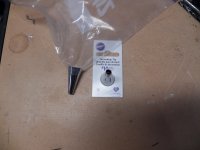I'll start this by saying that some years the manufacturer "sealed" the Edge of cutouts using their preferred sealant (A Bostik product, which seemed to be used for everything, including the water pipe connections where threads were mis-matched!) They even sent me 3 tubes of it, when I discovered that had not sealed the joint between the cabin top and aft bulkhead on the Tom Cat 255.
Second, no matter what product you use, the surfaces must be really clean. Any prior sealant should be removed. (If silicone has been used, it seems to get into the "pores" of the fiberglass, and keep other materials from sticking in the future, even though it often is not a good adhesive.).
Lots of good information in the thread. But we all may have different experiences and backgrounds.
Generally the ONLY silicone type product which I believe should be used on the exterior a boat is Boat Life Life Seal--it is a hybrid urethane/silicone product, and is OK for plastics. (There is an exception of a specific polymer of silicone used for bedding Polycarbonate; aka Lexan) However, the Bomar hatches are aluminum framed, so the 4000 which is UV resistant, is satisfactory.
My objection to butyl tape is that I have removed hundreds of fastenings which were bedded with it, and invariably there has been both water and dirt intrusion under the butyl tape. Basically the butyl tape is being used as a gasket, which depends on fasteners remaining very tight. As butyl tape ages, it looses some adhesive property. Manufactures used it because it is faster and cheaper than other sealants. But these same manufactures don't seal the core properly--!!
Even better is to use solid glass laminates or specific blocks of embedded water resistant materials, in areas of fasteners or high shear loads.
Yes, 5200 can be removed, use Marine Debond, which is both expensive and very time consuming. I removed some pieces of teak which were used as stops for a small propane stove in the galley last year. The use of wooden or plastic wedges will help give "lift", also score the 5200 seal with a razor knife (like "Xacto" ) to create an entry point into the core of the 5200 bead. Harder on horizontal surfaces. Even on the Debond web site, they admit professionals take 30 minutes to remove 12" of Debond.
For the thickening of Epoxy, I prefer a mixture Cabosil (Fumed Silica), and medium density filler, mixed to a "peanut butter" consistency. It is stiff enough to stay in place--but I recognize that the duct tape trick certainly has its place.
I feel one should coat the core (balsa) with "neat" or unthickened epoxy. I just mix the epoxy, brush on the coating to the core using a glue brush. Then add the thickening agent.
Obviously we have differences of opinion based on our own experiences. I'm not saying that my techniques are any better than any other--but have worked for me. I started working on fiberglass boats in 1952 when Glasspar donated a dozen 12 foot skiffs at Camp Fox, Catalina Island, where one of my duties was repairing the wooden skiffs which the campers used. They also left a gallon of poly ester resin some MEKperoxide catalyst and pieces of fiberglass mat and cloth. My experience with butyl tape is mostly from RV's which I have owned continuously since 1962.

